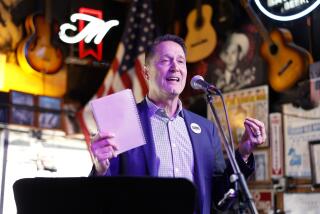Editorial: ‘Rhapsody in Blue’ is in the public domain. Rap version, anyone?

- Share via
George Gershwin’s “Rhapsody in Blue,” which he wrote and debuted in 1924, was a daring melding of jazz with classical music. In the years since, the lush, vibrant composition has become an instantly recognizable classic of American music.
And since New Year’s Day, it has belonged to everyone. For the first time in 96 years, it may be performed or recorded for free, without special permission or other requirements, by any community group that wants to, or by any orchestra, or by any aspiring piano player who simply wants to post a version on YouTube. Filmmakers can use it too, and, yes, every advertising company . Until now, anyone who wanted to play the piece as part of a public concert or commercial venture had to get permission and pay a fee for the privilege — which put it out of reach of many. But on the first day of 2020, “Rhapsody in Blue” entered the public domain — along with tens of thousands of other works of art, including musical compositions, books, plays and films, all from 1924.
That long wait to the public domain was the result of the Sonny Bono Copyright Term Extension Act, which Congress passed in 1998 and which extended copyrights by an extra 20 years — effectively freezing the status quo in place for two decades, so that few if any published works came out of copyright until 2018. Works from the 1920s and 1930s that were about to lose their copyright protection in the 1990s are only starting to come into the public domain now.
The law, passed with the strong support of Disney and other Hollywood studios, kept in place for a couple of extra decades the highly lucrative copyrights on Disney’s Mickey Mouse, among other cartoon stars. Finally, last January, more than 50,000 works of literature alone — to say nothing of the many thousands of other works of art — were freed from copyright restrictions. 2020 marks the second giant infusion of work into the public domain. Thomas Mann’s “The Magic Mountain” and E.M. Forster’s “A Passage to India” as well as movies from Buster Keaton (“Sherlock, Jr.” and “The Navigator”) and Harold Lloyd (“Girl Shy” and “Hot Water”) and the first film adaptation of “Peter Pan” all enter the public domain this year. (Mickey Mouse still has four more years of protection.)
Of course, copyrights protect artists and and writers and musicians — and movie studios — and hopefully spur them all on to create and produce more work. Copyrights also ensure that creators are able to take full advantage of the market for their works. But eventually, after decades of protection and long after the death of the creators, works should become part of the public domain so that they can be more widely enjoyed and so that other artists can be freed to use elements of those works to create something new. They become part of the building blocks of the culture, like notes on a musical scale.
Now you can turn “A Passage to India” into an opera or use a Buster Keaton movie in a music video without jumping through hoops. A rap artist can refashion “Rhapsody in Blue” into something related but different, for free. That means less money, obviously, for Gershwin’s heirs and his publishers, but, 96 years after “Rhapsody in Blue” was created, they’ve had an awful lot of protection.
Gershwin himself was influenced by the music of others as he wrote “Rhapsody in Blue,” saying he considered his piece “a sort of musical kaleidoscope of America, of our vast melting pot.” Playwright Eugene O’Neill — whose “Desire Under the Elms” comes into the public domain this year — adapted themes of Greek tragedy to a rural New England setting in that play. Luckily for O’Neill, Greek tragedies were in the public domain.
As a result of this year’s mass copyright expiration, thousands of works will enter the public domain and be rediscovered by inquisitive scholars and artists and writers and readers. Archivists will now be allowed to put thousands of books online, and the prices of the books to consumers will go down. Silent films that have not disintegrated can now be digitized and saved by preservationists.
There can be unpleasant side effects when creative work loses copyright protection. We may soon hear “Rhapsody in Blue” in a lot more TV ads, perhaps for a carpet cleaner or laundry detergent. On the other hand, by putting work into the public domain, we allow other artists to experiment with it, thereby encouraging the next Gershwin. We make it more easily available to the public. And we acknowledge that after a certain point, certain cultural touchstones belong to all of us. That’s a worthy trade-off.
More to Read
A cure for the common opinion
Get thought-provoking perspectives with our weekly newsletter.
You may occasionally receive promotional content from the Los Angeles Times.









